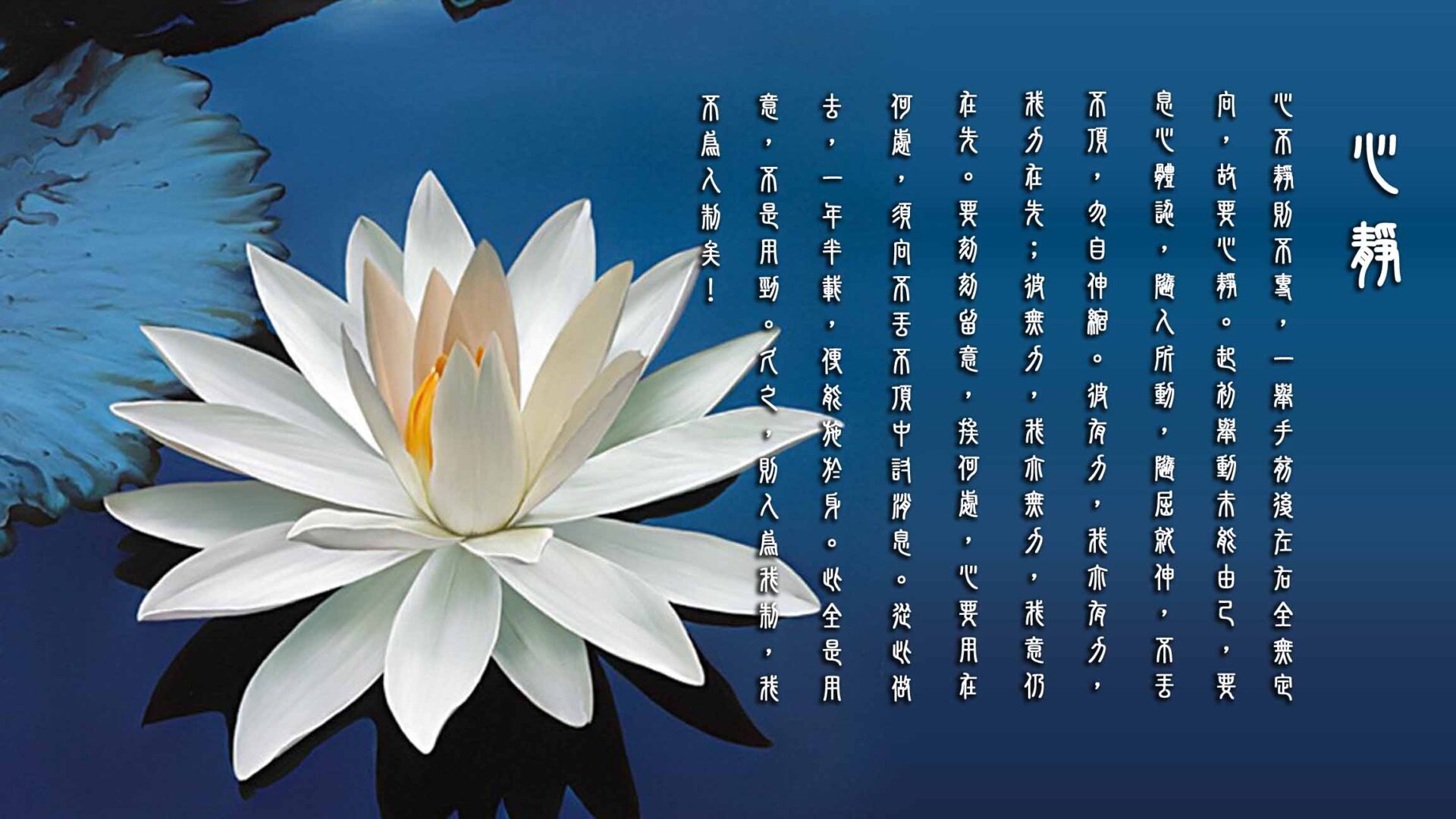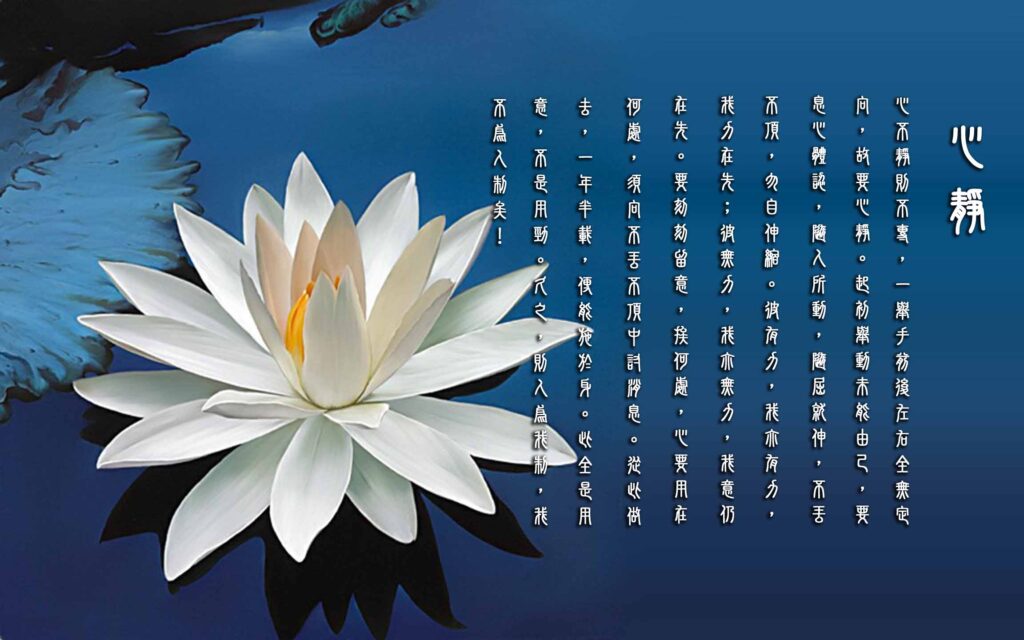心不靜則不專,一舉手前後左右全無定向,故要心靜。起初舉動,未能由己,要悉心體認,隨人所動,隨曲就伸,不丟不頂,勿自伸縮。彼有力,我亦有力,我力在先。彼無力,我亦無力,我意仍在先。要刻刻留心,挨何處,心要用在何處,須向不丟不頂中討消息。從此做去,一年半載,便能施於身。此全是用意,不是用勁,久之,則人為我制,我不為人制矣。
TRANSLATION
If the heart and mind is not calm, one cannot concentrate. When the arm is raised, it does not know which direction to go. Therefore, it is necessary to first achieve calmness.
When a move begins, do not move on your own. Instead, listen carefully and follow your opponent. Bend and straighten without retreating or over extending, never yielding and never resisting. If my opponent has strength, I also have strength but my strength leads. If my opponent does not have strength, I am also without strength but my intent still leads.
Be constantly mindful of your body and the contact point. Go with your heart. Seek information in the midst of not yielding and not resisting. Train this way for up to half or one year, it will then become instinctive. All of this should be done with intention, not with force. Over time, I will control the opponent and no one can control me.
EXTERNAL FACTORS
A calm heart and mind is the prerequisite to any Tai Chi training. An advanced practitioner can achieve this state no matter what the surroundings may be. A beginner or intermediate student may find it difficult. To help practitioners achieve this state, finding a good training facility is an important first step. The practice space should be free of distractions allowing one to easily immerse into a state of calm and peace.
Distractions are many and can come in the form of any noise, smell, sight and spatial obstacles. A quiet environment with soft gentle music in the background is ideal. Assure it is free of nauseous fumes, perfume or cigarette smoke. The flooring should be level and free of clutter or obstacles. The space should have sufficient lighting and room to move without one person running into another.
All these are external factors that can affect a person’s ability to stay calm and concentrate. As the practitioner’s skill level increases, these external factors slowly become less important. With practice, the practitioner’s ability to focus and concentrate strengthens. Over time, the person’s state of mind becomes more relevant to achieving a calm heart and mind than the external distractions of the space.
INTERNAL FACTORS
To begin, the first thing to learn is good posture. To achieve good posture, we need to gain an awareness of how it feels to be centred. We may begin by looking at ourselves in the mirror to see if our posture is straight. A good tai chi teacher will guide the student to sense a well-aligned posture by feel instead of merely by sight.
The next step is to release tension in our body. To do this, it will require focusing our mind on the different parts of our body with a slow scan from head to toe. When the tension in our physical body releases, calmness naturally returns to our body.
At the beginning of every tai chi form, we start by getting into a stance with our feet shoulder width apart. This stance is a moment for the practitioner to align their posture and achieve relaxation and calmness. After this first moment of calmness, the sequence of movements and pauses continues relentlessly to the completion of the form. Take advantage of this initial stance to achieve the calm that you wish to pervade the practice of a tai chi form.
A student who has only been practicing for a short while might take a few minutes to reach calmness in this starting stance. An intermediate student might take seconds to achieve the calmness. A tai chi master would be calm instantaneously.
FORMS PRACTICE
To achieve and maintain calmness throughout your forms practice, attention must always be focused on one of the tai chi principles. It is challenging to do when you are beginning to learn and remember the movements. Many people want to rush into learning more moves. Instead, it is better to learn just a few movements first and practice a single basic principle applied throughout these movements.
The principle of achieving and maintaining a calm heart and mind is a good starting point for incorporating basic principles into the movements of our forms. To start, focus on maintaining a well-aligned posture through all the movements. In fact, do not try to practice a different principle each time you practice the form. Instead, it is best to choose just one principle and stick with it until you have achieved a good deal of success with applying it to your movements.
If you begin your tai chi training in this manner by always focusing on a single principle such as calmness, you will practice calmness each and every time you are practicing the tai chi form. With this much consistent practice, by the time you finish learning the whole form, calmness will become second nature.
As your skill advances, this prerequisite of achieving calmness does not go away. Instead, you will get to know and learn additional advanced principles. Choose different ones to focus your practice and achieve a more complete and deeper understanding of calmness. As your skills advance to higher levels, always remember this foundational method for achieving calmness. Even a tai chi master makes mistakes if she allows her mind to wander.
PUSH HANDS PRACTICE
The verse on Calmness heavily references push hands training. The way to achieve calmness in push hands is to focus on the contact point with your opponent and your own body’s centre simultaneously.
Focusing on the contact point allows you to “listen” to your opponent so you will be able to follow and stick. Focusing on your body allows you to adhere to the principle of yin-yang while you are continuously following your opponent. These two focus points go hand-in-hand. You cannot focus on one while disregarding the other.
So how do you go about achieving calmness if you are constantly worrying about your body and sticking with your opponent? The key lies in relaxing or releasing tension in the body. It is the same principle used in forms practice to achieve calmness.
When you relax your body, the contact point becomes soft and merges with the opponent. Your ability to sense changes in your opponent also increases when your body is void of tension. At this stage, you have given up yourself to merge with the opponent. Sticking or following is no longer an issue. Calmness takes over. The only thing left to do is to continue your focus of maintaining calmness as you move with your opponent.
GO WITH YOUR HEART
Regardless of your skill level as a beginner, intermediate or advanced tai chi practitioner or whether you are practicing forms or push hands, “Go with your heart”. The saying refers to feeling your way through this principle. Start with your mind paying attention to a principle, then learn it as a feeling that your body will always remember. Your ability to learn this principle is enhanced when you rid your body of tension to make room for calmness to settle into the body instead. When this happens, your goal is achieved.




